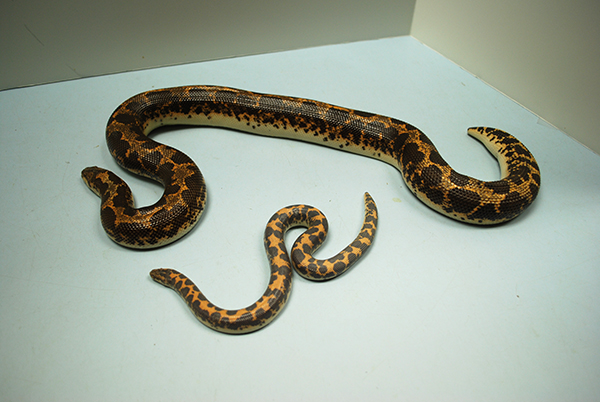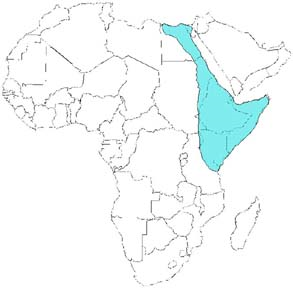Kenyan Sand Boa
Kenyan Sand Boa
Gongylophis (Eryx) colubrinus loverdgei

 General Information
General Information
Family: Boidae
Locale: East Africa, deserts & savannas of Kenya Egypt, Yemen, Sudan, Ethiopia, Chad, Niger & Tanzania
Habitat: Semi-arid regions, sand desert, low humidity
Average Size: 22-24 inches for females; 15-20 inches for males
Average Life span: 15-20+ years
Activity: Nocturnal
Care Summary
Captive Care: 10 gallon tank (or shoe boxes) for babies; 10-20 gallon for a pair of adults, with several inches of play sand (newspaper or Carefresh paper bedding), no succulent plants, only dry weathered driftwood, Manzanita branches, and rocks. Heavy cage furniture must be firmly affixed, as the animal will tend to burrow under stuff and could be squashed. Cage humidity must be kept low, but the animal should have access to drinking water. One solution is to use a small “Rubbermaid”-type container with a hole cut in the top as a water dish and partly bury it in the sand. Never fill the dish more than half full. Under-tank heating for half the tank establishes a thermal gradient. Some breeders recommend adding a humid hide box, a plastic box with an access hole cut in the lid or upper side, half filled with damp sphagnum moss or vermiculite, to aid in shedding. The box must be checked frequently for droppings or mold.
Temperature: Gradient from 94-96˚F to 77-84˚F
Lighting: Special lighting not required, incandescent light for warmth
Diet: Neonates (young hatchlings) prefer lizards or pinkies scented with lizard odor. Some will accept newly born mice. Feed weekly when young, decreasing the frequency as they mature. They are mature at 15 months. Adults feed on lab mice or rat pups. Size of food item should be as big around as the largest part of the snake. They need access to drinking water at least periodically and it is best to feed them at night.
Breeding: Breeding begins in mid-late spring and parturition occurs about 4-5 months later in late summer or early autumn. Using 2-3 males with one female increases better success with larger litters. When females are gravid, they prefer warmth, and may seek basking sites which exceed 95˚F. Females breed biennially. The young are fairly large, about 8 inches long, and they usually have 10-20 per litter.
Temperament: They are head shy, so approach from the rear.
Notes: Sexually dimorphic – females larger than males. Head and tail similar in appearance. Spends a majority of its time buried in sand. Generally docile, but may nip if startled.
References
Bartlett, P.P., Griswold, B., Bartlett, R.D. (2001). Reptiles, Amphibians, and Invertebrates, an identification and care guide. Barron’s Educational Series, Hauppauge, NY. 279pp.
Boyd, D. (2015). Received from http://www.reptilesmagazine.com/Kenyan-Sand-Boa-Information-and-Care/
Ross, R., Marzec, G. (1990). The Reproductive Husbandry of Pythons and Boas. Institute for Herpetological Research, PO Box 2227, Stanford, CA 94305.
Walls, G.J. (1994.) Boas, Rosy and Ground. T.F.H. publications, Inc., Neptune City, NJ. 64pp.
Range Map: http://www.kingsnake.com/sandboa/colubrin.html
Compiled by Eileen Underwood. Updated 6/2016.
The Herpetarium is a facility in the Department of Biological Sciences.
Bowling Green State University | Bowling Green, OH 43403-0001 | Contact BGSU Herpetarium | Campus Map
Updated: 04/13/2021 12:23PM

 General Information
General Information